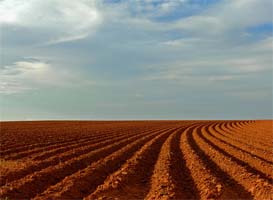Gypsum improves the soil structure of hardsetting or crusting sodic clay topsoils, not only by reducing swelling, but also preventing clay dispersion. Sodic topsoil (0-10cm) usually has very poor structure – it is waterlogged when wet and too hard when dry.
Sodic soil has too much sodium linking clay particles and not enough calcium. Sodic soil also tends to be unstable and prone to dispersion because of a lack of electrolyte.
Applying gypsum to the top soil gives a more friable soil that is less likely to swell and waterlog when wet and have a lower strength when dry. Such a soil forms a seedbed that promotes a higher plant density due ti the increased seedling emergence.
Other possible benefits of gypsum application to sodic clay topsoils includes:
- increased intake of water,
- less wear on implements,
- reduced fuel consumption,
- lower soil adhesion to harvested root crops such potatoes,
- improved access after heavy rain or irrigation.

Reference: NSW Agfacts AC.10
You have visited the REGYP News Room, for more info please visit the full REGYP website www.regyp.com.au , or call 1300 4 REGYP (73497) or email info@regyp.com.au for more information.

